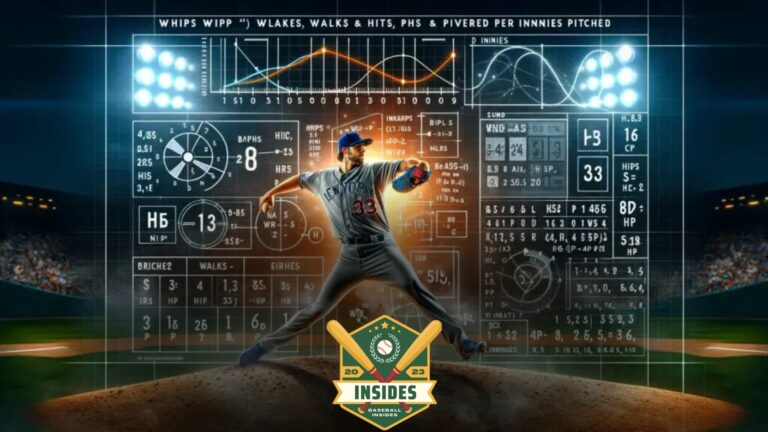
In this article:
What comes to mind when you hear MRP in the context of baseball? You might be imagining a sophisticated strategy or a secret code players use.
Well, it’s time to demystify this acronym. The term MRP stands for Middle Relief Pitchers in baseball.
So why is this important? Because MRP, or Middle Relief Pitchers, play a crucial role in the game, often determining the trajectory of the match. They work like the unsung heroes of the game, stepping in when the starting pitcher tires and before the closing pitcher takes over.
- “MRP in baseball isn’t just a term. It’s a pivotal role that can make or break the game.”
So, strap in, baseball fans. We’re about to take a deep dive into the world of MRP in baseball, exploring who they are, what they do, and why they’re so important.
Basics of MRP in Baseball
If you’re a baseball enthusiast, you’ve probably come across the acronym MRP. But what exactly does it mean? MRP, in the context of baseball, stands for “Most Recent Player.”
Understanding MRP
The term MRP, or Most Recent Player, refers to the latest player who has played in a baseball game. This could be a batter who just stepped to the plate, a pitcher who just stepped on the mound, or a fielder who just made a play.
Why MRP Matters
Knowing who the MRP is can be crucial, especially in strategy-based scenarios. For instance, a manager might consider the MRP’s performance when making lineup decisions or pitching changes.
Keeping Track of MRP
Keeping track of the MRP can be a complex task, given the fast-paced nature of baseball. However, sports broadcasters and stat providers keep fans updated with real-time information.
MRP and Baseball Statistics
Like all other baseball statistics, the MRP can tell a story about a game’s progress. It offers a snapshot of the game’s most recent action, adding another layer to the rich tapestry of baseball statistics.
MRP Definition and Explanation in Baseball
Baseball, a sport full of acronyms, often leaves fans and novices alike scratching their heads. Have you ever encountered the term MRP in the context of baseball and wondered what it meant? Don’t worry, you’re not alone.
In the world of baseball, understanding the composition of a team is crucial, which begs the question, “How many baseball players are on a team?” This fundamental aspect highlights the structure and strategy behind the game.
What is MRP?
The acronym MRP commonly stands for ‘Middle Relief Pitcher’ in baseball. It’s a term that designates a specific type of player, and no, it’s not about providing relief in the middle of a stressful game!
The Role of an MRP
So, what does a Middle Relief Pitcher do? Their role is quite critical. The MRP comes into the game after the starting pitcher has been removed but before the setup man and closer come in to finish. They’re the bridge between the starting and finishing pitchers, hence the term ‘middle’.
The Importance of an MRP
Why is this role important? Well, MRPs play a vital part in preserving the lead or keeping the game close. They take over when the starting pitcher tires, preventing the opponent from gaining momentum. Their ability to efficiently manage this phase can be a game changer.
MRP – Not Just Any Pitcher
MRPs are not just any pitchers. They are usually expected to pitch one to two innings, face batters from both sides of the plate, and often pitch on consecutive days. This requires a unique set of skills and versatility, making them an invaluable asset in a team’s pitching arsenal.
The Factors that Determine MRP in Baseball
If you’re a baseball enthusiast, you’ve probably encountered the term MRP. But what exactly does it mean in baseball? MRP, or Marginal Revenue Product, quantifies the added value a player brings to a team in terms of revenue.
It’s a key term in baseball analytics, but its calculation involves several factors.
Economic Principle
The concept of MRP in baseball stems from economics. It measures how much additional revenue a player can generate for their team.
In baseball terms, a player’s MRP is directly linked to their on-field performance, which in turn influences ticket sales, merchandise, and broadcast rights.
Player Performance
Performance is a significant determinant of a player’s MRP. A player who consistently delivers high performance will likely draw more fans, increasing revenue.
Performance metrics such as batting averages, home runs, RBIs (runs batted in), and ERA (earned run average) for pitchers are crucial in determining MRP.
Team Performance
It’s not just individual player performance that matters; team performance also plays a key role in determining MRP. When a team performs well overall, every player’s MRP is likely to increase.
So, a player’s value isn’t just about their contributions but how they contribute to the team’s overall success.
When delving into the intricacies of baseball statistics and gameplay, one might come across the term “hold.” But what exactly is a hold in baseball? This metric offers a deeper insight into the effectiveness of middle relievers, further enriching our appreciation of the game’s subtleties.
Market Factors
Market factors such as the size and demographics of a team’s market also impact a player’s MRP. Teams in larger markets with more fans will generally have higher MRPs.
Additionally, teams with a strong and loyal fanbase can often support higher player MRPs, regardless of market size.
Media Coverage
Media coverage is another key factor that influences MRP. Players who receive more attention from the media are more likely to attract fans and generate revenue for their team.
Therefore, it’s unsurprising that popular players with heavy media coverage often have higher MRPs.
Understanding MRP in baseball requires a grasp of both sports and economics. It’s a fascinating look into the value players bring to their teams beyond their on-field performance.
So, next time you hear the term MRP, you’ll know exactly what it means and the factors that determine it!
How MRP Impacts a Team’s Success in Baseball
When understanding a team’s success in baseball, the role of MRP, or Marginal Revenue Product, can’t be overlooked. In economics, MRP is a vital concept applied to sports, including baseball, with astonishing results.
MRP in baseball, essentially, is the additional revenue a team earns because of one more unit of input, or in simple terms, a player. It’s a measure that helps to identify the true value a player brings to a team in terms of revenue.
The Influence of MRP
So, how exactly does MRP impact a baseball team’s success? Let’s break it down.
- Player Valuation: MRP helps teams accurately value their players. Does a star player’s salary justify the revenue he brings in? MRP can help answer that.
- Strategic Decisions: Teams can use MRP to make informed decisions on player trades, drafts, and contract negotiations, thus positively impacting their performance and the balance sheet.
- Team Performance: A deeper understanding of MRP can help teams assemble a more balanced and efficient roster, improving on-field performance.
MRP in Action
Let’s take a look at how MRP plays out in real-world baseball.
For instance, a star pitcher may command a high salary, but if he brings in substantial revenue – through ticket sales, merchandise, broadcast rights, and more – his MRP could be high, justifying the expenditure.
On the flip side, a lesser-known player with a lower salary but significant on-field impact could have a surprisingly high MRP, making him a valuable asset to the team.
Through understanding and leveraging MRP, baseball teams can make smarter, more strategic decisions, leading to greater success on the field and in the financial books.
MRP vs. Other Baseball Stats: What’s the Difference?
MRP, or Marginal Revenue Product, is a baseball stat that’s often overlooked, but it brings quite a unique perspective to the game.
Unlike other stats, MRP is not about batting averages, runs, or hits. Instead, it’s all about economics and a player’s value to the team.
Understanding MRP
MRP calculates the revenue a player generates for his team per each extra win his performance contributes. It’s a deeper look at a player’s financial worth beyond his skills on the field.
It gives us a new way to evaluate players, especially regarding contract negotiations and trades.
How MRP Differs From Other Stats
While other baseball stats like batting average (BA), on-base percentage (OBP), and slugging percentage (SLG) reflect a player’s performance, MRP focuses on the economic impact of that performance.
It measures the tangible financial value a player brings to his team. This is what sets MRP apart from traditional baseball stats.
MRP’s Role in Baseball
The MRP statistic is particularly useful to team owners and managers. It offers a more balanced view of a player’s worth, aiding in making informed decisions about salaries, contracts, and player acquisitions.
It’s not just about how well a player performs but also about how much revenue that performance generates for the team.
The Top Players with High MRP in Baseball Today
As a die-hard baseball fan, you’re probably wondering who’s got the highest MRP in the game today. For those not in the know, MRP stands for Marginal Revenue Product, a concept that estimates a player’s economic value to their team.
Let’s dive into the big leagues and check out the players knocking it out of the park regarding MRP.
1. Mike Trout
First up on our list is none other than Mike Trout. With an MRP value that’s consistently high, Trout’s contribution to the Los Angeles Angels is undeniable. His game-changing performance on the field translates into some serious economic clout.
2. Mookie Betts
Next, we have Mookie Betts. Playing for the Los Angeles Dodgers, Betts brings a high MRP to the table thanks to his exceptional skills and stellar performance. There’s no question about it — Betts’ economic value to his team is substantial.
3. Gerrit Cole
On the pitcher’s mound, we find Gerrit Cole. His MRP is through the roof, reflecting his vital role in the New York Yankees’ lineup. Cole’s hard work and dedication pay off through his high economic value to the team.
4. Jacob deGrom
Another pitcher making the high MRP list is Jacob deGrom. As a key player for the New York Mets, deGrom’s contribution is reflected in his impressive MRP. His outstanding performance ensures that he brings serious value to the team, both on and off the field.
These players are worth every penny, and their high MRPs are a testament to their exceptional contributions to their respective teams.
So next time you’re watching a game, remember that MRP isn’t just about the stats on the field — it’s about the value players bring to the game.
Tips for Improving Your MRP in Baseball
If you’re a baseball enthusiast, you may have encountered the term MRP, which stands for “Most Recent Performance”. This statistical measure evaluates a player’s latest performances, giving teams and fans an accurate picture of a player’s current form.
Now, if you’re a budding baseball star looking to up your MRP, here are some tips to consider.
Consistency is Key
In baseball, as with any sport, consistency is king. An athlete who regularly performs at a high standard will likely have a higher MRP. So, strive for consistency in your game.
Focus on Skill Development
Improving your overall skills is another way to enhance your MRP. Whether batting, fielding, or pitching, put in the time to practice and perfect your skills.
Physical Conditioning
Physical conditioning is essential to withstand the long and demanding baseball season. A player in peak physical condition will undoubtedly perform better, positively impacting their MRP.
Stay Mentally Sharp
Baseball is as much a mental game as it is a physical one. Focusing, making smart decisions, and staying calm under pressure can improve your MRP.
Learn from Every Game
Every game is a learning opportunity. Analyze your performances, take note of your mistakes and successes, and apply these insights to future games to increase your MRP.
Remember, there’s no shortcut to improving your MRP in baseball. It takes consistent effort, skill development, physical conditioning, mental strength, and continuous learning.
So, please put on your cleats, grab your bat, and let’s make that MRP sky-high!
The choice of equipment in baseball can significantly affect how the game is played, especially in younger leagues. This leads us to explore why Little League uses aluminum bats, a decision that impacts everything from player safety to the dynamics of the game.
Conclusion
Understanding the role of Middle Relief Pitchers (MRP) in baseball is fundamental to appreciating the strategic nuances of this fascinating sport.
From bridging the gap between starters and closers to maintaining the team’s edge in tight games, MRPs are indispensable contributors to their team’s success.
Key Takeaways:
- MRPs are the bridge between starting and closing pitchers.
- They can significantly impact the game’s trajectory with their performance.
- Understanding the role of MRPs helps deepen your appreciation of baseball strategy.
So, next time you’re watching a baseball game, keep an eye on the Middle Relief Pitchers. Their role might not be as flashy as the starters or closers, but their contribution is no less crucial. After all, in baseball—as in life—it’s often the unsung heroes who truly make a difference.
FAQs
What does MRP mean in baseball?
In the realm of baseball, MRP stands for Middle Relief Pitcher. This is a type of pitcher who typically enters the game after the starting pitcher and before the closing pitcher.
What is the role of an MRP?
The MRP’s role is to maintain or, sometimes, reclaim the lead in the middle innings of the game. This position is crucial because it bridges the gap between the starter and the closer.
How long does an MRP typically play?
While there’s no hard and fast rule, a Middle Relief Pitcher usually plays for one to three innings.
Is the MRP a starter or a closer?
No, the MRP is neither a starter nor a closer. They play in the middle innings, hence the name Middle Relief Pitcher.
How is the performance of an MRP measured?
The performance of an MRP is often measured by ERA (Earned Run Average), WHIP (Walks and Hits per Inning Pitched), and holds.
What is a hold in baseball?
A hold is a statistic that measures the effectiveness of middle relief pitchers. An MRP earns a hold when they enter a save situation, record at least one out, and leave the game without giving up the lead.
Can a Middle Relief Pitcher become a Starter or Closer?
Yes, a Middle Relief Pitcher can develop their skills and become a Starter or Closer. However, this transition is rare and requires significant performance improvement.
Are MRP players less skilled than starters or closers?
Not necessarily. While starters and closers often receive more attention, MRP players play a critical role in the team’s success and require a unique set of skills.
How many MRP players does a team usually have?
There’s no specific number, as it varies from team to team. However, most teams have multiple MRP players to manage the middle innings effectively.
What makes a good MRP player?
A good MRP player has a robust mix of pitches, is reliable under pressure, and can quickly adjust to different situations. They need to be versatile and ready to face any batting order.






